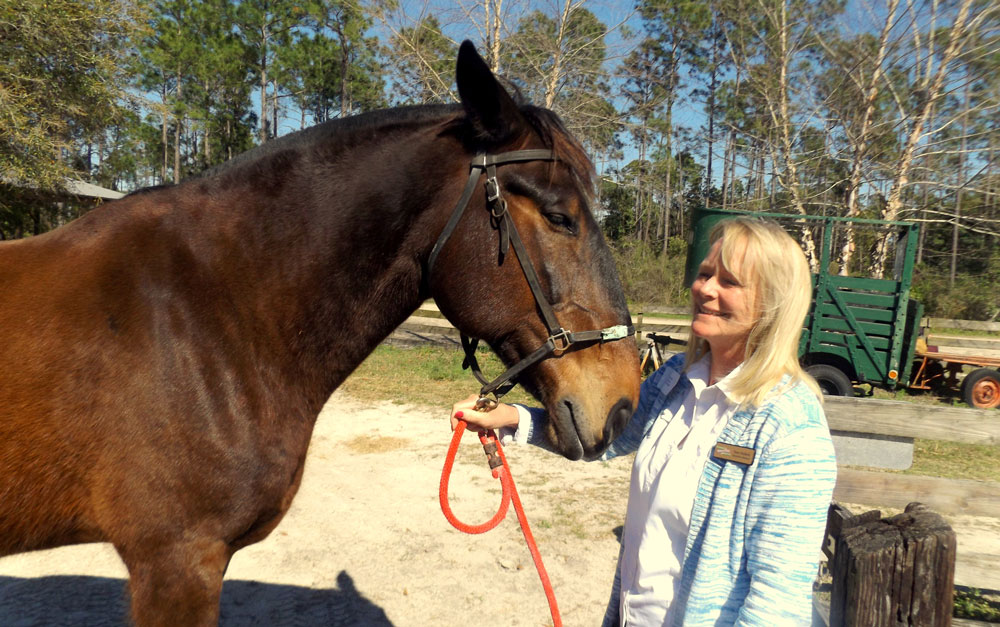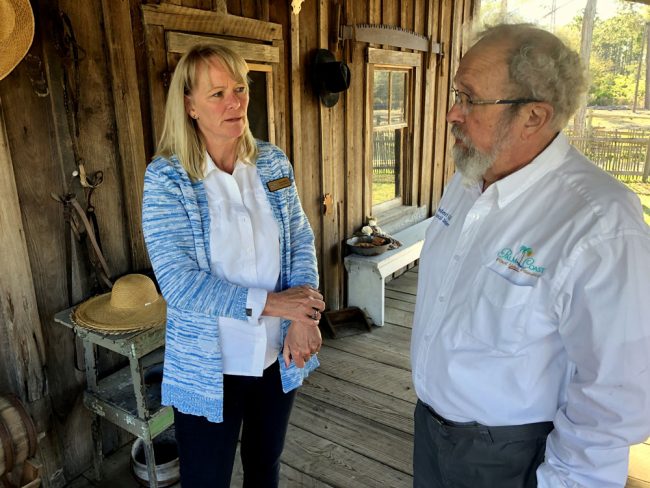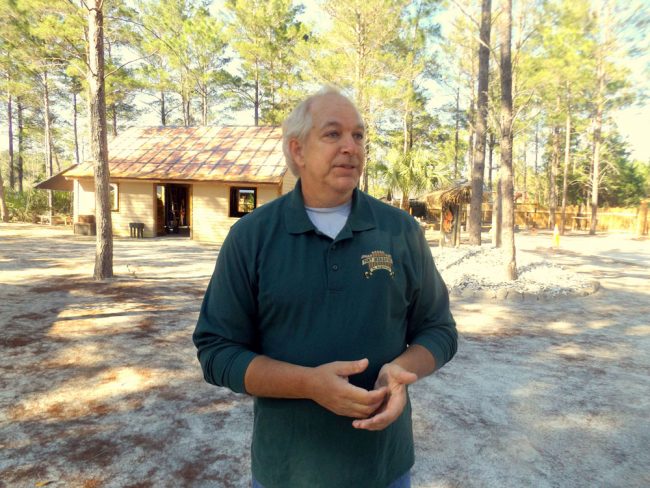
Dan Carignan, educational director of the Florida Agricultural Museum, has a treat for youngsters who visit its new complex, the Old Florida Museum, which last August relocated from St. Augustine to the ag museum in Palm Coast.
In a place that specializes in telling the stories of things old – the state’s Spanish colonial presence, an authentic 1880s Florida Cracker homestead, Florida’s role as the first destination of the Underground Railroad, the history of Florida’s citrus industry, the state’s equestrian heritage – Carignan shares the granddaddy of artifacts for visitors to handle and ponder: As part of the Old Florida Museum’s Dirt Detectives archaeology program, Carignan passes around a piece of coprolite that’s at least 66 million years old.
“We don’t tell the kids what it is,” he says. “We say ‘Smell it, do whatever you need to do to take a guess at what you think it is.’ When it comes back to me, I say, ‘OK, I will tell you what this is – it’s petrified dinosaur poop.’ And all the kids are like ‘Ewwww, that’s poop!’ And you know that’s what they go home and tell mom and dad at the dinner table – ‘I touched poop today! It was awesome!’ ”
Petrified dino dung is not the only new thing at the ag museum, which was founded in 1983 in Tallahassee through the initiative of Agricultural Commissioner Doyle Conner, and is an official state museum under Florida’s Division of Agriculture and Consumer Services. In 1992, it was designated the Museum of Agriculture and Rural History of the State of Florida. In 1997 it was rechristened as the Florida Agricultural Museum when it moved to its new home on 460 acres at 7900 Old Kings Road North in Palm Coast, right in the southwest corner where U.S. 1 and I-95 intersect in north Flagler County.

Kara Hoblick, in her fourth year as executive director, says the ag museum also is planning to introduce programs and activities that tell the stories of modern-day farming and ranching, such as “farm-to-table” dining events featuring local produce and farmers talking about how they raise their crops.
All this hustle and bustle, Hoblick says, is happening at a museum that was on the brink of closing when she came on board in July 2016 as interim director. Though the facility is an official Florida state museum, it operates as a private nonprofit (501.C3) corporation led by a board of trustees, and has an annual budget of approximately $300,000.
“We are loosely under the Department of Ag as a ‘direct support organization,’ ” Hoblick says. “But we are not state employees. We are a private nonprofit. All the funding that we receive has to be raised on our own. Just like any other nonprofit organization or government entity, we can submit an appropriation request to the state legislature. That has to go through many hoops to be approved.”
During the crisis four years ago, Hoblick was a volunteer at the museum with a background in marketing, advertising and sales. “The director at that time left, and somebody asked me to take the position as interim director and I said ‘Absolutely not,’ ” she recalls with a laugh. “There was no funding, not enough income, too many expenses including tax penalties, lack of interest, no volunteers. There were only three employees at the time. We had lost our insurance due to horse-related claims” stemming from the museum’s equestrian boarding and riding programs.
Because of deed restrictions on the property, if the museum failed it would revert back to Flagler County pending a vote by the county commission. But, with the commission down to four members due to the death of one commissioner, that vote deadlocked at two-to-two. The commission passed a subsequent motion to have the county temporarily take over the museum and its financial obligations, Hoblick says.

“So, during that time we regrouped, got people excited about helping out, got more volunteers. The timing was right. The economy was better, people were ready for this. We really clawed our way out of the hole.” When the county relinquished control of the museum in March 2017, Hoblick was named permanent executive director.
The ag museum’s annual $300,000 budget comes from various sources, with its equestrian programs providing 40 percent and memberships and donations contributing 20 percent.
“That’s the only way the museum will survive – by having various sources of revenue,” Hoblick says. “The horses have been a long-standing and very stable part of the funding equation.” Some 20 horses are boarded on the grounds, including 10, owned by the museum, that are used for riding lessons and guided trail rides. Private citizens also pay the museum to board their horses there.
The ag museum also gets revenue from fees for its educational tours, from renting its facilities for weddings and birthday parties, from hosting public events such as historical re-enactments, and from leasing two billboards on I-95 that were donated by Flagler County.
The museum has 13 paid staff and “most are part-time,” Hoblick says. Approximately 40 volunteers also work at the facility.
Hoblick’s annual salary is $56,000, but, she says, “I have personally cut my salary when there was no money. I’m approved for up to $56,000 but I have never taken $56,000.”
She is bullish about the future of the ag museum.
“When I stepped foot on this property, I was honestly speechless because of the potential,” she says. “This place is a gem, or it could be a gem. I kept looking around at all of the possibilities and for whatever reasons this place just never came into its own. It’s had some successes, but it’s never really taken off, and it had a lot of downward turns for various reasons.
“But this is the right time. We have fantastic, amazing, passionate people on board who want this place to succeed. We have the attention of politicians. We have fantastic support from Flagler County. The economy is good. People want to come out to the country. People are tired — especially parents are tired of the electronics that kids are just constantly focused on. So we are saying hurry up and get here and slow down, put your cell phones and your electronics away and come out and enjoy.”
Here’s a look at what’s new at the ag:
Old Florida Museum
After more than 20 successful years as part of the Fort Menendez family attraction in St. Augustine, the facility’s owner sold the property to new owners who did not plan to continue the historical program. The owner bequeathed the Old Florida Museum concept to Carignan, who was the operations manager there.
“The owner basically said ‘Here you go Dan, you have yourself a museum,’ ” Carignan says. “I said, ‘What am I going to do with it?’ ”
An ag museum volunteer heard about the closing of Fort Menendez and suggested to Hoblick that the St. Augustine facility might have something the ag museum could use. Hoblick contacted Carignan.
“The ag museum graciously offered to give us a piece of land and help fund the reconstruction of the buildings,” Carignan says.
The ag museum took out a loan to begin phase 1 construction of the Old Florida Museum on two acres of its land, and the latter currently is offering five educational programs to school groups, with a sixth program due to start later this year.

“If we get a percentage of it, we will be happy, but if we get nothing it will not halt any progress – it will just slow it down,” she said. “We will keep going. We will jump right in with both feet and be prepared to ask again next year.”
“We are a hands-on, interactive museum,” Carignan says. “Kids come in here from all over the state of Florida. They get to touch, feel, do crafts and activities. We teach them about Florida history. We follow the Sunshine State Standards. We have some teachers who have been coming to us close to 20 years.”
The Old Florida Museum programs include:
* Dirt Detectives – An archaeological program that features that petrified dinosaur dung as well as Yamasee Indian pottery, whale bones and other artifacts. Yes, youngsters can dig in dirt that has been seeded with artifacts.
* Pioneer Homestead – Features the Clark House, an authentic Florida Cracker homestead dating to the 1880s. The program also features a tour of the ag museum’s corral which includes Cracker cattle, horses and sheep descended from Spanish colonial breeds. The program, however, is not a petting zoo.
* Ships and Sailors – Includes a 70-foot partial replica of a Spanish caravel, a type of ship that could sail not only on the high seas but also up shallower rivers.
* Spanish Colonial/Fort Mose – Fort Mose, founded in 1738 just north of St. Augustine, was the first free black settlement in the Americas. The Spanish had decreed that freedom would be granted to any African-American slave in the English colonies in the Carolinas who reached the Spanish colony — if they would convert to Catholicism. Thus the first Underground Railroad in North America ran south to Florida as escaped slaves sought their freedom, Carignan says.
* Timucua Indian – Explores the natives of North Florida known as the Timucua Indians.
* Florida Cracker – Coming later this year, this program explores the lifestyles of pioneers who settled in the area after 1821, when the United States acquired Florida from Spain. Those pioneers were called “Florida Crackers” because of the cracking sound their whips made as they herded cattle.
Train Rides
The Northeast Florida Live Steamers & Railroaders Inc. has begun work on building a boarding platform/depot and laying down tracks along a one-mile stretch on ag museum grounds for the club’s rideable 1/8-scale train.
“They were located at Bostwick to the west of us on private property,” Hoblick says. “They were looking for a more public place to have their train tracks so they could attract more members and raise money, because it’s very expensive to create the train cars, the engines and the tracks.
“We connected with each other and the board said yes. It’s a fantastic partnership and it brings a whole new bank of volunteers to us. They’ve fallen in love with the museum just like all of us do.”
The route through woods will be “a gorgeous ride,” Hoblick says. Long-range plans call for additional track to “meander through the museum property.”
The railroader club is funding 100 percent of the project and will be providing the train engines and cars. Museum patrons will pay an additional fee, to be determined, to the club for train rides.
New Horse Arena
Kaleb, the giant museum horse – a cross between a Percheron and a Standardbred – has a new place to give museum visitors a ride beside the trails: a 150-by-250-foot fenced arena whose surface is a mix of sand and imported clay.
“The entire property is just an ancient sand dune so it’s all sugar sand, which is not the safest for horses to work in,” Hoblick says. “So that clay material was brought in by dump trucks.”
As for Kaleb, “he is pretty famous out here,” Hoblick says. “He pulls the wagons and he goes on trail rides. Even though he is huge, he is just a big teddy bear. He is the perfect horse if somebody is timid about horses at all. Within minutes he puts that person at ease. It’s as if he knows ‘OK, you’re nervous about me so I will show you I’m just a big teddy bear.’ ”
Meldrim Cottage
The Meldrim Cottage is the first house added to the museum property in 10 years. The St. Augustine home was built in the 1940s and was part of the last surviving turpentine operation in Florida, and at one point that operation was the largest in the state.
The cottage will temporarily house administration offices, but long-range plans call for it to display timber and turpentine artifacts.
“We have so many artifacts that are in storage, and a lot of items that were donated by the Florida Division of Forestry,” Hoblick says.
Contemporary agriculture programs
The ag plans to offer more “farm-to-table” dining events featuring local produce and talks by the farmers who grow those crops. One recent event featured purple sweet potatoes grown by Blue Sky Farms, which was established in 1987 by owner Danny Johns in Hastings, known as “Florida’s Potato Capital.” Johns’ family has farmed in the area since 1923 when they moved to Florida from their farm in Rockford, Ill.
The museum also plans to invite agricultural commodity groups to help create exhibits that show how specific commodities are cultivated.
“For example, what is the process of growing the strawberry plant?” Hoblick says. “How do you milk a cow? Grow cotton?”
The ag also has its eyes on the future of agriculture, Hoblick says: “We need to connect with entities like the University of Florida and their research department. Solar technology and drones are huge now in agriculture. The best way to tell those stories will be through workshops and informational events.”
![]()
The Florida Agricultural Museum is at 7900 Old Kings Road North, Palm Coast. Hours are 10 a.m.- 4 p.m. Thursday through Sunday. Admission is $9 adults, $7 children ages 6-12, free for children 5 and younger, $30 for a family up to five members with additional family members at regular price. Information: 386-446-7630 or online at floridaagmuseum.org.




























Thrilled says
Congratulations to all involved! How exciting to see this treasure growing and successful!! Just what we all need to take us back… and forward!
Linda says
This is one of the MOST awesome places in Flagler County! Kara has done an outstanding job.